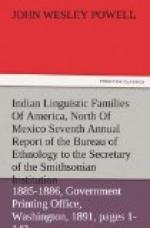Data of this loose character would of course be worthless in an attempt to fix boundary lines in accordance with the ideas of the modern surveyor. The relative positions of the families and the relative size of the areas occupied by them, however, and not their exact boundaries, are the chief concern in a linguistic map, and for the purpose of establishing these, and, in a rough way, the boundaries of the territory held by the tribes composing them, these data are very important, and when compared with one another and corrected by more definite data, when such are at hand, they have usually been found to be sufficient for the purpose.
SUMMARY OF DEDUCTIONS.
In conclusion, the more important deductions derivable from the data upon which the linguistic map is based, or that are suggested by it, may be summarized as follows:
First, the North American Indian tribes, instead of speaking related dialects, originating in a single parent language, in reality speak many languages belonging to distinct families, which have no apparent unity of origin.
Second, the Indian population of North America was greatly exaggerated by early writers, and instead of being large was in reality small as compared with the vast territory occupied and the abundant food supply; and furthermore, the population had nowhere augmented sufficiently, except possibly in California, to press upon the food supply.
Third, although representing a small population, the numerous tribes had overspread North America and had possessed themselves of all the territory, which, in the case of a great majority of tribes, was owned in common by the tribe.
Fourth, prior to the advent of the European, the tribes were probably nearly in a state of equilibrium, and were in the main sedentary, and those tribes which can be said with propriety to have been nomadic became so only after the advent of the European, and largely as the direct result of the acquisition of the horse and the introduction of firearms.
Fifth, while agriculture was general among the tribes of the eastern United States, and while it was spreading among western tribes, its products were nowhere sufficient wholly to emancipate the Indian from the hunter state.
* * * * *
Linguistic families.
Within the area covered by the map there are recognized fifty-eight distinct linguistic families.
These are enumerated in alphabetical order and each is accompanied by a table of the synonyms of the family name, together with a brief statement of the geographical area occupied by each family, so far as it is known. A list of the principal tribes of each family also is given.




